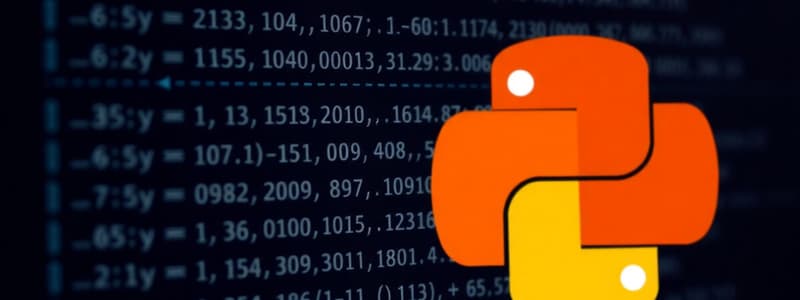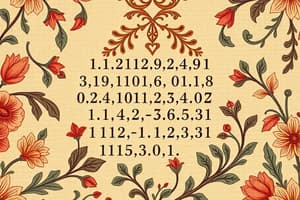Podcast
Questions and Answers
Which of the following is NOT a category into which Python divides operators?
Which of the following is NOT a category into which Python divides operators?
- Quantum Operators (correct)
- Logical Operators
- Bitwise Operators
- Arithmetic Operators
Arithmetic operators in Python can only be used with integer values.
Arithmetic operators in Python can only be used with integer values.
False (B)
What is the purpose of the // operator in Python?
What is the purpose of the // operator in Python?
- It returns the modulus (remainder) of a division.
- It performs floor division, returning the integer part of the division. (correct)
- It raises a number to a power.
- It performs standard division, returning a float result.
What is the result of the expression 17 % 5 in Python, and what does the '%' operator represent?
What is the result of the expression 17 % 5 in Python, and what does the '%' operator represent?
In Python, the operator ** is used for ______.
In Python, the operator ** is used for ______.
Which assignment operator is equivalent to x = x * (y + z)?
Which assignment operator is equivalent to x = x * (y + z)?
The expression x //= y is a valid Python assignment operator that performs floor division and updates x.
The expression x //= y is a valid Python assignment operator that performs floor division and updates x.
Describe the difference between the assignment operators = and == in Python.
Describe the difference between the assignment operators = and == in Python.
Which of the following comparison operators checks if two values are NOT equal?
Which of the following comparison operators checks if two values are NOT equal?
Comparison operators like > and < can only be used with numeric values and not with strings.
Comparison operators like > and < can only be used with numeric values and not with strings.
The logical operator that returns True only if both conditions are True is ______.
The logical operator that returns True only if both conditions are True is ______.
What will be the output of the following Python code?
x = 5; y = 10; print(not(x > 3 and y < 15))
What will be the output of the following Python code?
x = 5; y = 10; print(not(x > 3 and y < 15))
In Python, the not operator has higher precedence than the and operator.
In Python, the not operator has higher precedence than the and operator.
Explain the difference between the and and or logical operators.
Explain the difference between the and and or logical operators.
In bitwise operations, what does the term 'bitwise' refer to?
In bitwise operations, what does the term 'bitwise' refer to?
Bitwise operators in Python operate directly on decimal numbers.
Bitwise operators in Python operate directly on decimal numbers.
The bitwise operator & in Python performs a bitwise ______ operation.
The bitwise operator & in Python performs a bitwise ______ operation.
What is the result of the bitwise operation 5 | 3?
What is the result of the bitwise operation 5 | 3?
The bitwise NOT operator (~) inverts all the bits of a number, including the sign bit.
The bitwise NOT operator (~) inverts all the bits of a number, including the sign bit.
Explain what a left shift operator (<<) does at the bit level and provide sample usage.
Explain what a left shift operator (<<) does at the bit level and provide sample usage.
What is the result of the operation 5 >> 1 (right shift by 1) in Python?
What is the result of the operation 5 >> 1 (right shift by 1) in Python?
In Python, the function used to evaluate a value or variable and return a Boolean value (True or False) is ______.
In Python, the function used to evaluate a value or variable and return a Boolean value (True or False) is ______.
In Python, an empty list [] evaluates to True when converted to a Boolean.
In Python, an empty list [] evaluates to True when converted to a Boolean.
Given x = [1, 2, 3], y = [1, 2, 3], and z = x, what is the output when print(x is y, x is z) is executed?
Given x = [1, 2, 3], y = [1, 2, 3], and z = x, what is the output when print(x is y, x is z) is executed?
Explain the difference between the is and == operators in Python. Provide a usage example.
Explain the difference between the is and == operators in Python. Provide a usage example.
Two strings with identical content will always return True when compared with the is operator.
Two strings with identical content will always return True when compared with the is operator.
What is the primary purpose of membership operators in Python?
What is the primary purpose of membership operators in Python?
The ______ operator in Python is used to check if a value is NOT present in a sequence.
The ______ operator in Python is used to check if a value is NOT present in a sequence.
If x = [1, 2, 3] then the expression 4 in x will return True.
If x = [1, 2, 3] then the expression 4 in x will return True.
Briefly explain the concept of operator precedence in Python and why it is important.
Briefly explain the concept of operator precedence in Python and why it is important.
Which of the following operators has the highest precedence in Python?
Which of the following operators has the highest precedence in Python?
Multiplication always has higher precedence than floor division in Python.
Multiplication always has higher precedence than floor division in Python.
In Python, operators with the same precedence are evaluated from ______ to ______.
In Python, operators with the same precedence are evaluated from ______ to ______.
What is the output of print(2 + 3 * 4 ** 2)?
What is the output of print(2 + 3 * 4 ** 2)?
Evaluate the Python expression and provide the final integer result: print(8 >> 1 + 2).
Evaluate the Python expression and provide the final integer result: print(8 >> 1 + 2).
Using parentheses alters the order of operations in a Python expression.
Using parentheses alters the order of operations in a Python expression.
In Python, when there are multiple operators with the same precedence in an expression, they are generally evaluated from ______ to ______.
In Python, when there are multiple operators with the same precedence in an expression, they are generally evaluated from ______ to ______.
Match the following Python operators with their descriptions:
Match the following Python operators with their descriptions:
Given x = True and y = False, what is the result of x and (y or not y)?
Given x = True and y = False, what is the result of x and (y or not y)?
Flashcards
Arithmetic Operators in Python
Arithmetic Operators in Python
Operators that perform common mathematical operations on numeric values.
Assignment Operators
Assignment Operators
Assigns values to variables, such as =, +=, -=, *=
Comparison Operators
Comparison Operators
Operators used in logical statements to determine equality or difference.
Logical Operators
Logical Operators
Signup and view all the flashcards
Bitwise Operators
Bitwise Operators
Signup and view all the flashcards
Identity Operators
Identity Operators
Signup and view all the flashcards
Membership Operators
Membership Operators
Signup and view all the flashcards
Operator Precedence
Operator Precedence
Signup and view all the flashcards
What are Booleans?
What are Booleans?
Signup and view all the flashcards
What does bool() do?
What does bool() do?
Signup and view all the flashcards
What does in do?
What does in do?
Signup and view all the flashcards
What does not in do?
What does not in do?
Signup and view all the flashcards
Study Notes
Groups of Operators in Python
- Python categorizes operators into arithmetic, assignment, comparison, logical, bitwise, identity, and membership groups.
Arithmetic Operators
- Arithmetic operators perform common mathematical operations using numeric values.
- Addition:
x + y - Subtraction:
x - y - Multiplication:
x * y - Division:
x / y - Modulus:
x % y(returns the division remainder) - Floor division:
x // y(returns the division quotient) - Exponentiation:
x ** y
Assignment Operators
- Assignment operators assign values to variables.
- Assignment:
x = y - Addition Assignment:
x += y(same asx = x + y) - Subtraction Assignment:
x -= y(same asx = x - y) - Multiplication Assignment:
x *= y(same asx = x * y) - Division Assignment:
x /= y(same asx = x / y) - Modulus Assignment:
x %= y(same asx = x % y) - Floor Division Assignment:
x //= y(same asx = x // y) - Exponentiation Assignment:
x **= y(same asx = x ** y)
Comparison Operators
- Comparison operators determine equality or difference between variables or values in logical statements.
- They test for true or false.
- Equal:
x == y - Not equal:
x != y - Greater than:
x > y - Less than:
x < y - Greater than or equal to:
x >= y - Less than or equal to:
x <= y
Logical Operators
- Logical operators determine logic between variables or values.
and: Returns True if both statements are true.or: Returns True if one of the statements is true.not: Reverses the result; returns False if the result is true.
Bitwise Operators
- Bitwise operators compare binary numbers.
- Operations are performed on 32-bit binary numbers and then converted back to Python numbers.
&(AND): Sets each bit to 1 if both bits are 1. Example:5 & 1(0101 & 0001 = 0001), which results in1.|(OR): Sets each bit to 1 if one of two bits is 1. Example:5 | 1(0101 | 0001 = 0101), which results in5.^(XOR): Sets each bit to 1 if only one of two bits is 1. Example:5 ^ 1(0101 ^ 0001 = 0100), which results in4.~(NOT): Inverts all the bits. Example:~5(~0101 = 1010), resulting in10.<<(left shift): Shifts left by pushing zeros in from the right; leftmost bits fall off. Example:5 << 1(0101 << 1 = 1010), which results in10.>>(right shift): Shifts right by pushing copies of the leftmost bit in from the left; rightmost bits fall off. Example:5 >> 1(0101 >> 1 = 0010), which results in2.
Identity Operators
- Identity operators compare objects to see if they are the same object with the same memory location.
is: Returns True if both variables are the same object.is not: Returns True if both variables are not the same object.- Variables x and y are distinct even if they have identical contents. The is operator returns False. The overloaded equality operator== would return True for the same test.
Membership Operators
- Membership operators test if a sequence is present in an object.
in: Returns True if a sequence with the specified value is present in the object.not in: Returns True if a sequence with the specified value is not present in the object.
Operator Precedence
- Operator precedence determines the order in which operations are performed.
- Multiplication (*) and division (/) have higher precedence than addition (+) and subtraction (-).
- Parentheses have the highest precedence and are always evaluated first.
- Operators with the same precedence are computed from left to right.
- From highest to lowest precedence: Parentheses, Exponentiation, Unary plus/minus/bitwise NOT, Multiplication/division/floor division/modulus, Addition/subtraction, Bitwise shifts, Bitwise AND, Bitwise XOR, Bitwise OR, Comparison/identity/membership operators, Logical NOT, Logical AND, Logical OR.
Python Booleans
- Booleans represent one of two values: True or False.
- Any expression in Python can be evaluated and will return either True or False.
- When comparing two values, the expression is evaluated, and Python returns a Boolean answer.
- The
bool()function evaluates any value and returns True or False. - Almost any value is evaluated to True if it has some sort of content.
- Any string is True, except empty strings.
- Any number is True, except 0.
- Any list, tuple, set, and dictionary are True, except empty ones.
Python Exercises
- Division operator (/) divides numbers.
- Modulus operator (%) returns the division remainder.
- Floor division (//) returns the division quotient.
- Arithmetic assignment operators are a shorthand way of performing arithmetic operations.
- The
<<operator inserts the specified number of 0s from the right and lets the same amount of leftmost bits fall off. - Bitwise right shift has a lower precedence than subtraction.
Studying That Suits You
Use AI to generate personalized quizzes and flashcards to suit your learning preferences.





